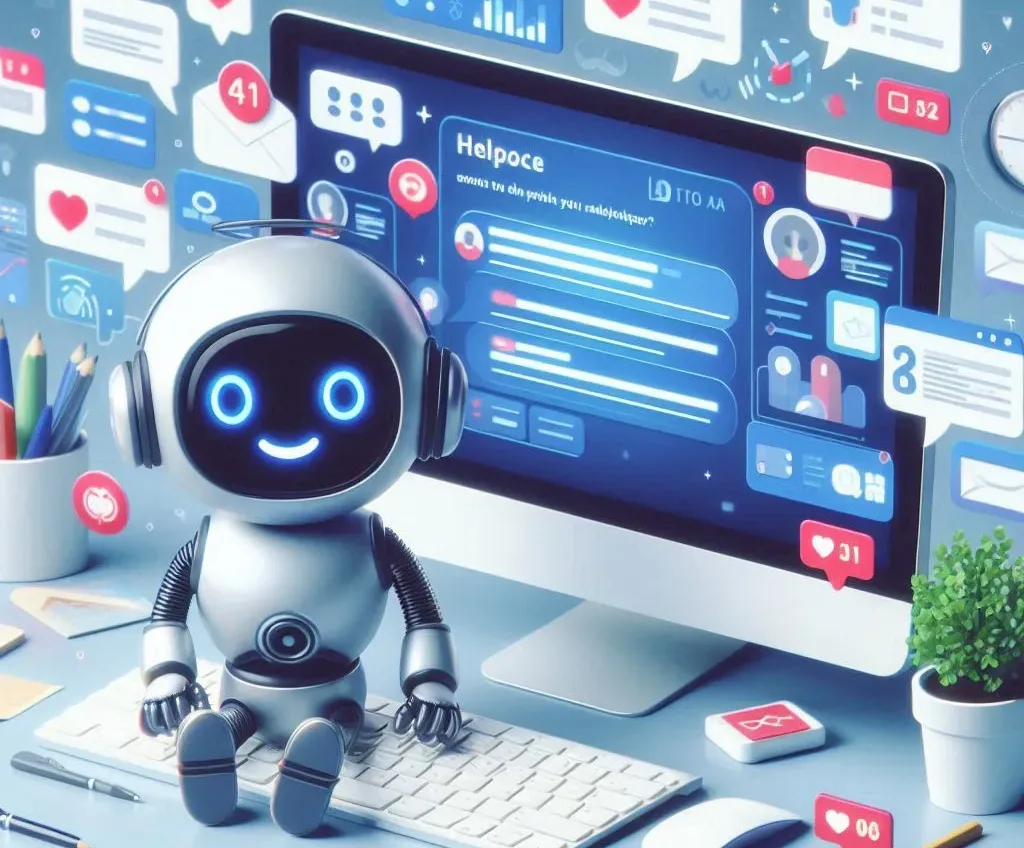In the vast digital landscape of social media, finding content that resonates with your interests can be like searching for a needle in a haystack. Enter Artificial Intelligence (AI), the unseen force that’s revolutionizing how we discover and engage with content on platforms like Instagram, Twitter, YouTube, and TikTok. This article delves into the sophisticated AI systems behind these platforms, exploring how they work to serve you content that keeps you scrolling, liking, and sharing.
The AI Revolution in Social Media
The Need for Intelligent Content Curation
With billions of users generating and consuming content at an unprecedented rate, manual content curation has become impossible. Social media platforms have turned to AI to solve this challenge, developing complex algorithms that can understand, categorize, and recommend content at scale.
Key Components of AI in Social Media
- Machine Learning: Algorithms that improve through experience
- Natural Language Processing (NLP): Understanding and analyzing text
- Computer Vision: Processing and analyzing visual content
- Deep Learning: Advanced neural networks for complex pattern recognition
- Recommender Systems: Personalized content suggestion engines
Platform-Specific AI: A Closer Look
Let’s explore how AI works on some of the most popular social media platforms:
Instagram: Visual AI Mastery
Instagram’s AI system is a marvel of computer vision and user behavior analysis. Here’s how it works to keep you engaged:
Image Recognition and Classification
Instagram’s AI can recognize objects, scenes, and even emotions in images. This allows the platform to categorize content without relying solely on user-generated tags.
Key features:
- Object detection in photos and videos
- Scene classification (e.g., beach, city, nature)
- Facial recognition for tagging suggestions
Engagement Prediction
The AI predicts how likely you are to engage with a post based on your past behavior and the post’s characteristics.
Factors considered:
- Your interaction history
- Post popularity among similar users
- Time spent viewing similar content
Explore Page Algorithm
The Explore page is a testament to Instagram’s AI prowess, offering a personalized window into content you might like but don’t yet follow.
How it works:
- Analyzes posts you’ve liked, commented on, or saved
- Identifies users with similar interests
- Suggests content popular among those users
- Continuously refines suggestions based on your interactions
Twitter: Taming the Real-Time Firehose
Twitter’s AI has the unique challenge of processing and recommending content in real-time. Its systems are designed to handle the platform’s fast-paced nature.
Natural Language Processing for Tweet Analysis
Twitter’s NLP algorithms work overtime to understand the context and sentiment of tweets.
Capabilities:
- Topic classification
- Sentiment analysis
- Trend detection
User Interest Modeling
The AI builds a complex model of your interests based on your tweets, retweets, likes, and follows.
Key aspects:
- Dynamic interest graphs that evolve over time
- Weighting recent activity more heavily
- Considering the strength of connections in your network
Timeline Ranking Algorithm
Your Twitter timeline is not strictly chronological; it’s curated by AI to show you the most relevant tweets first.
Ranking factors:
- Tweet relevance to your interests
- Engagement level of the tweet
- Your relationship with the tweet’s author
YouTube: The Video Recommendation Powerhouse
YouTube’s recommendation system is one of the most sophisticated in the social media world, processing vast amounts of video content and user data.
Content-Based Filtering
YouTube’s AI analyzes the actual content of videos to understand what they’re about.
Techniques used:
- Audio transcription for speech recognition
- Visual element analysis
- Metadata examination (titles, descriptions, tags
Collaborative Filtering
The system also looks at viewing patterns across its user base to identify similarities.
How it works:
- Identifies users with similar viewing histories
- Recommends videos that similar users have enjoyed
- Continuously updates recommendations based on collective user behavior
Watch Time Optimization
YouTube’s AI is particularly focused on recommending videos that will keep you watching for longer.
Factors considered:
- Video quality and engagement rates
- Your average watch time for similar content
- Time of day and device you’re using
TikTok: The AI-Driven Short Video Phenomenon
TikTok’s rapid rise to popularity is largely due to its highly effective AI-powered “For You” page.
Video Understanding AI
TikTok’s AI can analyze multiple aspects of a video in seconds.
Elements analyzed:
- Visual components (objects, scenes, actions)
- Audio features (music, voice, sound effects)
- Text overlays and captions
User Behavior Analysis
The AI closely monitors how you interact with videos to refine its understanding of your preferences.
Behaviors tracked:
- Videos you watch to completion
- Content you create
- Accounts you follow
- Comments and shares
The “For You” Algorithm
TikTok’s “For You” page is a personalized stream of videos tailored to each user’s interests.
How it works:
- Starts with a diverse range of videos
- Observes which ones you engage with
- Quickly narrows down to content types you prefer
- Occasionally introduces new content types to prevent filter bubbles
Common AI Techniques Across Platforms
While each platform has its unique approach, there are some common AI techniques used across social media:
Reinforcement Learning
AI systems on these platforms often use reinforcement learning, where the algorithm learns to make better recommendations based on the “rewards” of user engagement.
Application:
- Adjusting content rankings based on user interactions
- Optimizing notification timing for maximum engagement
Deep Neural Networks
Complex neural networks allow these AI systems to process and understand vast amounts of multi-dimensional data.
Use cases:
- Image and video classification
- Natural language understanding
- User behavior prediction
A/B Testing
Platforms continuously run experiments to improve their AI systems.
How it’s used:
- Testing different recommendation algorithms
- Optimizing UI elements for better engagement
- Evaluating new features before full rollout
The Ethics and Challenges of AI in Social Media
While AI has revolutionized content discovery, it also presents significant challenges:
Filter Bubbles and Echo Chambers
AI recommendations can sometimes lead to users being exposed to increasingly narrow viewpoints.
Potential solutions:
- Intentionally introducing diverse content
- Allowing users more control over their feed algorithms
Privacy Concerns
The effectiveness of these AI systems relies on collecting and analyzing vast amounts of user data.
Ongoing issues:
- Data collection transparency
- User control over personal data usage
- Compliance with data protection regulations like GDPR
Addiction and Mental Health
There are concerns that AI-optimized content feeds may contribute to social media addiction and negative mental health outcomes.
Industry responses:
- Implementing screen time management tools
- Promoting positive content and interactions
- Researching the long-term effects of AI-driven engagement
Content Moderation Challenges
AI plays a crucial role in content moderation, but it still struggles with nuanced issues.
Areas for improvement:
- Detecting subtle forms of hate speech or misinformation
- Balancing free speech with community safety
- Adapting to evolving language and cultural contexts
The Future of AI in Social Media Content Discovery
As AI technology continues to advance, we can expect even more sophisticated content discovery systems:
Multimodal AI
Future systems will likely be better at understanding content across different modes (text, image, video, audio) simultaneously.
Potential applications:
- More accurate content classification
- Enhanced contextual understanding of memes and short-form video
Explainable AI
There’s a growing push for AI systems that can explain their recommendations, increasing transparency and user trust.
Benefits:
- Users understand why they’re seeing certain content
- Easier detection and correction of algorithmic biases
Personalized AI Assistants
We might see the development of more interactive AI assistants within social media platforms.
Possibilities:
- AI-powered content creation suggestions
- Personalized content curation assistants
- Intelligent scheduling of posts for creators
Augmented and Virtual Reality Integration
As social media expands into AR and VR, AI will play a crucial role in creating immersive, personalized experiences.
Potential features:
- AI-generated virtual environments based on user preferences
- Intelligent AR overlays for real-world social interactions
Conclusion: The AI systems powering content discovery on platforms like Instagram, Twitter, YouTube, and TikTok are marvels of modern technology. They process enormous amounts of data to deliver personalized content experiences that keep billions of users engaged every day.
As these systems continue to evolve, they promise to make our social media experiences even more tailored and engaging. However, this progress also comes with the responsibility to address ethical concerns and potential negative impacts.
The future of AI in social media content discovery is not just about showing users what they want to see—it’s about striking a balance between engagement, diversity, and digital well-being. As users, understanding how these systems work empowers us to interact with them more consciously and to advocate for their responsible development. In the end, the goal of AI in social media should be to enhance our digital experiences, connect us with content and people we truly care about, and perhaps even broaden our horizons. As the technology advances, it will be fascinating to see how these platforms evolve and how our online social experiences transform along with them.




